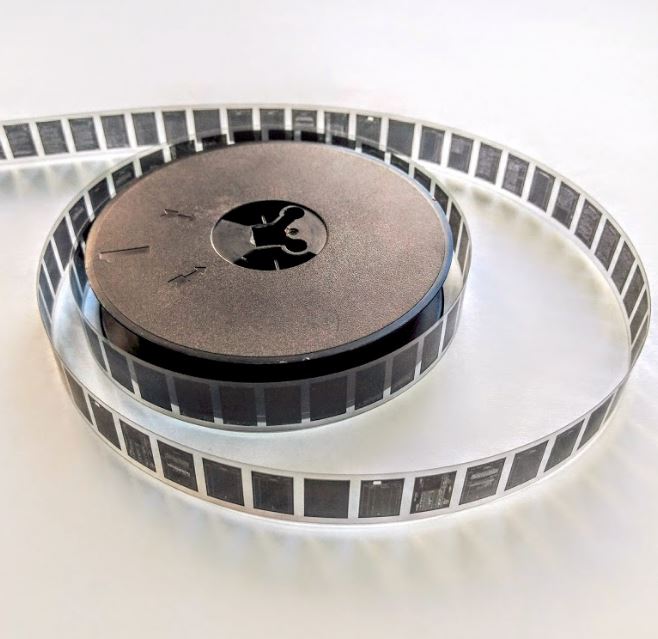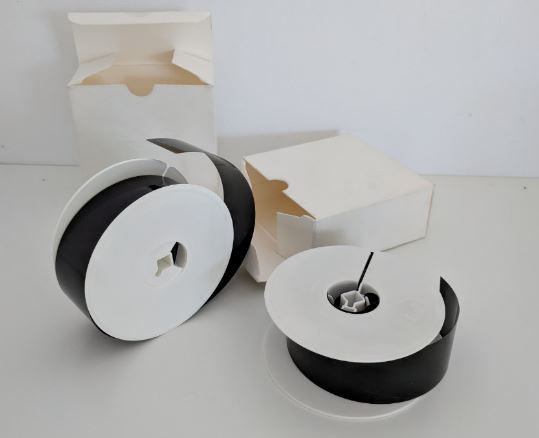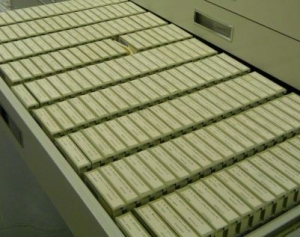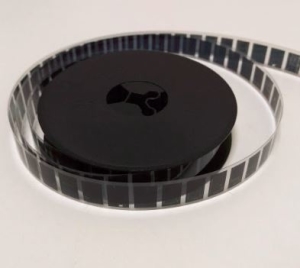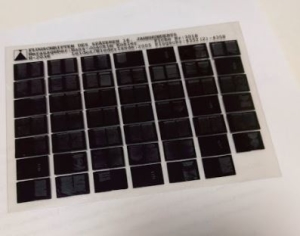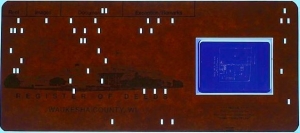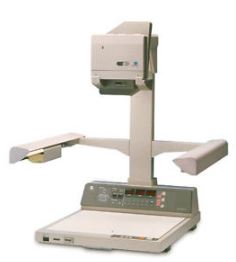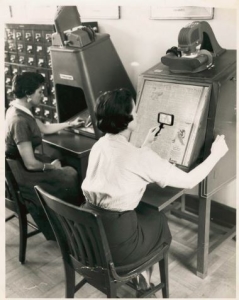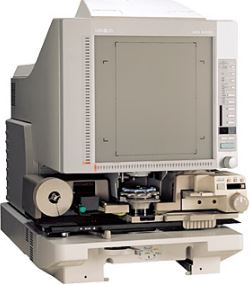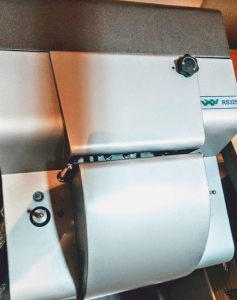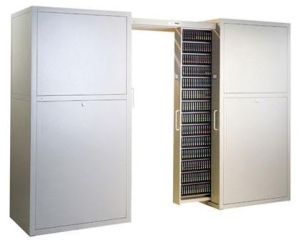If you’ve ever wondered what is microfilm, then read this article to understand this subject properly.
Honestly, this is a very reasonable question. Since it is only used by industry professionals, why would anyone know about it? Microfilm, microfiche, and microform in general. Not to mention the microfilming process or even scanning microfilm.
See, for the average Joe, he will not even remotely encounter microform or microfilm during his life. But for others, it may well turn out that they have to manage it, or even produce it.
With this article, we are trying to bring a couple of micrographic aspects forward and make them clearer.
Quick Navigation
We will try to brief you in about aspects such as :
- Microform, microfilm and microfiche – what are they used for, advantages and disadvantages
- How to produce microfilm
- How to digitize microform products
- Other aspects of the micrographics industry.
What is microfilm
Microfilm is a microphotographic type of film, used in the archiving industry. This type of media stores documents which are reduced by 24 or 36 times ( or even more ) to generate micro scale copies of the original documents. It is part of the microform family, alongside the microfiche. The main advantage of microfilm is the estimated lifespan of over 500 years.
A brief history of microfilm
- John Benjamin Dancer is regarded as the first one to use some kind of microfilm in 1839
- The biggest breakthrough came in 1928 when Eastman Kodak bought an invention from George Mccarthy a well-known banker
- The division of Kodak was called Rekordak and the certain microfilm cameras carried this trade name
- 1935 was the year when newspapers started becoming available on 35mm microfilm rolls.
- 1936 the American Library started endorsing microfilm and this is where the technology started catching traction
What is microfilm used for
As mentioned earlier, archivists, librarians, and other specialized individuals. Institutions require microfilm when they want to preserve information for long-term periods. Other industries who store on microfilm, are the judicial and pharma industry. The judicial system stores on microfilm because legal aspects tend to be critical aspects of a society. Pharma industry prefers microfilm for its longevity. And this leads us on to another subject.
Libraries, National archives, and other institutions with large archives use microfilm. Consider this, a roll can store up to 2500 documents. All of this, with a size of 10 x 10 cm x 2cm. This way, you can understand the benefits. Small microfilm storage spaces can deposit in excess of 10mil page archives. That is huge space savings and immediate access. All in one space. This should give you a better idea why archivists love working with microfilm.
Advantages of microfilm
To better understand the uses of microfilm we will first have to look at what are the advantages of using microfilm.
- Microfilm has a very long lifespan, expected to last over 500 years if stored properly.
- The microfilmed archive is the major insurance policy if we take into account major natural or human cause disasters
- It provides significant coverage over potential risk factors such as stealing information, copying or even fraudulent manipulation.
- We see that microfilm uses very little space meaning that you can store millions of pages in very small places.
- It’s a relatively cheap technology to use and maintain.
Disadvantages of microfilm
- Microfilm is still a challenge to use on a daily basis. You need both specialized equipment and experience to use it.
- Information retrieval can prove difficult if you don’t have the necessary expertise.
- Digital technology is starting to challenge microfilm in different archiving areas
- The industry is running low on experienced personnel
If you want to go further with your study, please go to this article on the advantages and disadvantages of microfilming.
Microform Media
Microfilm, just like any product, has different characteristics. These can be technical specifications or user choices regarding use of one or another type of microfilm.
Microfilm Rolls
- Microfilm is spooled on rolls and has different sizes and lengths. The height is either 16mm or 35mm. The length of the microfilm is variable but it’s usually either 30.5m or 66m.
Microfiche
- Microfiche uses the same technology as microfilm. It comes in sheets that are usually 148x105mm.
Aperture Cards
- Aperture cards are used less and less and they are usually a card with a microfilm slide incorporated in them.
- They contain a 35mm microfilm chip secured with tape. Most use cases are for architectural or engineering drawings.
Ultrafiche and Flat Film
- Flat film and ultrafiche are other alternatives of microform technology. Their uses are rather limited.
Types of microform based on material
- Silver Halide film is the most used type of microfilm and microfiche. It is now cheap enough and the most distributed.
- The vesicular film used to be a very cost-effective method for different applications. It is now less popular due to the reduction in the cost of the Silver Halide film.
- Diazo Duplicating film is used for the direct duplication of microfilm rolls. This method of duplicating is less and less used nowadays.
Explaining the difference between 16mm and 35 microfilm?
Let’s start with the 16mm film. This film has a height of 16mm and will be found in different lengths. It is mainly used for A3 and A4 documents. The machinery to write 16mm film has the advantage of being very fast. So fast, that it can provide writing speeds of 2 or even 3 times the speed of 35mm machinery. For larger projects, we can’t think of a better option than 16mm film.
We have seen even larger documents written on 16mm film. Consider that on 35mm film, larger documents are split into frames and then microfilmed. We can now do the same with 16mm film. This and the fact that writing speeds are high makes the 16mm film very attractive. 35mm film is mainly used for larger documents. It was a good option in the past when we didn’t have microfilm readers for high reduction. Now we have such readers, therefore, we can go with high reduction rates.
Grayscale or bitonal microfilm?
The difference between the two is that one is used for documents with text and images and the other for text only. You would say that going grayscale is the logical choice. Well, not really. Grayscale machines are slow. While this can be managed, most project nowadays is text documents only. We haven’t seen that many image-based projects around. For images, we think that color is the way to go. And since microfilming in color is very expensive, digital is the way to go for that. Microfilm is for documents, not graphic arts.
LE500 archival microfilm or standard microfilm
This is a no-brainer. LE500 archival microfilm is just a bit more expensive. And by a bit, we do mean just a bit. It won’t affect your budget. But it will give you a life expectancy of 500 years if stored appropriately. You are not saving a lot with standard film. So all the archival benefits are definitely worth it for archival microfilm. Not to mention the fact that it now comes in different lengths, from 30m to 66m.
We also feature an interesting article on types of microfilm.
Microfilming
Microfilm and microfiche can be created in two separate ways: using a microform camera or a microfilm writer.
Microfilm Camera
The microfilm camera is an analog camera that exposes the film to light shaped in the form of the document. This is a slow and lengthy process and it presumes you are directly converting paper documents to microfilm. In the past, the microfilm camera was attached to a microfilming table with a purpose-built lightning table.
Microfilm Writer
Such cameras are not used so often these days. The microfilm writer is slowly replacing it. Such a machine converts digitally created images ( either digitally born documents or scanned documents ) to microfilm media. The technology for creating microfilm and microfiche from digital files is rather similar. The main difference is that one handles microfiche media and the other reels of microfilm.
Follow the link for more information on microfilm writers and computer output on microfilm archive writers.
Hybrid machines for microfilm creation
The third category is the hybrid systems. These are usually high-speed document scanners which output documents both in a digital file and on microfilm media. In this way, a single effort will achieve both tasks. Still, the technology is still not reliable enough and limits you in different ways.
Read our article on the microfilming process for more information on the creation of microfilm. Also, this article shows you how to make microfilm.
Microfilming newspapers
As you probably know, microfilming newspapers is still a viable method to archive old broadsheets and tabloid papers. So what has changed over time and what is the best method to get a microfilmed newspaper.
Compared to the older days, when you used to microfilm the newspaper directly with a microfilm camera, these days we can scan and get a digital copy of the newspaper first. This is a great advantage compared to microfilming paper directly, as after the scanning process we can adjust the quality of the images and prepare the best input for the microfilm archive writer.
The second part of the process is the transfer of the digital scans to the archive writer. Before doing that, you can select to microfilm the newspaper either on a 16mm roll or a 35mm roll. This is usually related to the size of the newspaper. For example, a tabloid newspaper can be easily converted to 16mm microfilm rolls. On the other hand, for broadsheet newspapers, we highly recommend to use a 35mm roll.
The microfilm reader
A microfilm reader is a machine that reads microfilms. In Europe, some entities will call it a microfilm viewer. It works analogically and has a screen attached to it. Other machines project the images on walls. You will find microfilm viewers in libraries and other places where archives are open to the public. In the past researchers were huge fans of such equipment. At that moment, this was the quickest solution to find information stored on microfilm.
For better understanding, please see Luther’s College guide to using a microfilm reader.
Digital Microfilm viewer
Please see the answer to the above question. It is similar to a microfilm reader. Digital technology allows users to replace viewers with scanners. Some operators prefer holding on to viewers. This is especially the case for microfilming operators. We recommend you use viewers when inspecting microfilm. When you write microfilm, we recommend you take periodical checks of the film. For that, you should use the microfilm viewer, as it allows you to make on the fly checks.
To find out more on readers head to our article on microfilm machines.
Converting microfilm to digital
Microfilm can be converted from analog media to digital image or text files. For such purpose, special microfilm and microfiche scanners use linear or area CCD sensors to capture frames. High-quality lenses magnify the image to the original size it had before it was microfilmed.
With advances in capturing technology, microfilm scanners can capture even the images reduced 48 times. This is a major breakthrough in microfilm to digital conversion. It also allows us to store more documents on a single microfilm roll using higher reduction rates.
We have great articles that show you how to digitize microfilm or how to convert microfilm to pdf.
Our company can scan microfilms for you. Follow this link to check out our microfilm scanning services, while this post will show you our microfilm scanning prices.
Do you have microfiche? Our post on microfiche scanning services is perfect to read before you order these services.
Microfilm Duplication
Duplicating microfilms is important as it allows users to transfer copies quickly to third parties.
Diaco duplicators were the equipment of choice in the past, as it allowed for quick copies of microfilm rolls on diazo films. The benefits were the speed and reduced cost of the copy.
The downsides were the fact that it did not allow for strict quality control. A lot of the copies did not have archival properties and sometimes users could not even read the copies because of the low quality.
Nowadays we recommend you scan the original microfilm first. After that, the digital images are processed and can be written on an archive writer to allow for very good quality.
Microfilm Storage
Usually, this refers to purpose-built drawers. Manufacturers build such drawers to the specific size of roller cartridges. It can hold 16mm film or 35mm film. There are also systems that can hold both. Reliable manufacturers will build the microfilm drawers from special materials. This allows keeping specific humidity and temperature. Some of them are fireproof, adding an extra insurance policy.
See here a great example of microfilm storage at the Minnesota Historical Society.
Frequently asked questions
Here you can find a couple of the questions that people often ask about microfilm and microfilming in general.
When was microfilm invented?
Microfilm was first used sometime during 1920’s in the banking industry. The main application of the microfilm records was the backup of banking statements and different financial documents.
George Mcarthy filed a patent for his special microfilming machine, which he called The Chekograph.
What is microfilm used for?
Microfilm is mainly used in the document archiving industry. At its popularity peak it was the main solution to store copies of large archives in a very compact and efficient manner. With the evolution of digital archiving, microfilm took a reserve role, but it’s still used for long term archiving.
How to make microfilm?
Microfilming or creating microfilm copies of various documents is the process in which the physical document is transferred to a photographic film at a specified reduction value. The higher the reduction value, the larger the volume of documents that can be stored on a microfilm roll.
If you are interested in this subject you can check our page on how to make microfilm and microfiche, but also you can view our page on the microfilming process.
How to scan and digitize microfilm?
To scan and digitize microfilm you first need a specialized microfilm scanner. This works using a capturing sensor and a magnifying lens. With a special software each image is captured, magnified and outputed to a digital file format that. This file format can be PDF, TIFF, Jpeg or even word or excel files.
If you are interested on how this process works, please head to our page on microfilm digitization, or if you need to scan film, head to our microfilm scanning services page.
What is a microfilm system?
Usually it’s hard to define a microfilm system, but in most cases this is related to a microfilm camera or a microfilm archive writer. The camera uses special lighting to illuminate the documents and then capture each one individually, to transfer them to microfilm. The archive writer does more or less the same thing, but it uses digital files that are usually scanned documents and it converts them to microfilm.


